This story is published in The Industry Issue of our member exclusive newspaper, Life & Thyme Post. Get your copy.
In the spring and summer of 2021, a burst of eye-catching headlines temporarily shifted the restaurant industry’s attention from Covid relief to plant-based eating. “The New Menu at Eleven Madison Park Will Be Meatless,” said The New York Times. Just a month prior, Gauthier Soho, a high-end restaurant in London, made a similar claim. By the fall, a slew of casual eateries were following suit, from trendsetters in eco-inclined cities to bold outliers in the heart of cattle country. Across social media, progressive consumers quickly clamored to support these newly vegan-friendly restaurants. Yet for the countless individuals who have built their careers in agriculture, these eye-catching culinary proclamations mask the true complexity of striving toward sustainable land management.
As a sixth-generation California rancher, Darrell Wood is intimately acquainted with the impacts of our changing climate. Just this summer, his family lost a ranch near Lassen Volcanic National Park—part of the one million acres burned by the prolific Dixie Fire. Yet as he moves his herds across an increasingly parched landscape—ranging from sea-level to 8,000 feet on the eastern side of the Sierra Nevada—he sees a clear sense of opportunity amidst the loss.
“If you look at Northern California today, we see that privately managed forests—which still include grazing in their practices—have hardly burned at all,” Wood notes. “It’s primarily forest service lands, which haven’t incorporated grazing, that have burned catastrophically in recent years.” Whether cattle, mountain sheep, antelope or bison, this proactive grazing helps diminish low-lying brush and the overall fuel loads available to wildfires. Perhaps this should be no surprise, given that the American landscape evolved symbiotically to be managed by such herbivores—notably, an estimated 30 to 60 million bison that dominated our grasslands until their mass killing in the 1800s.
The terrain where Wood’s cattle graze is often too steep, rocky or sandy for conventional farming. More than two-thirds of all soil in the United States is unsuitable for planting crops—yet this is precisely where grasses can thrive. To sustain growth in these climates, grasses must be repeatedly clipped, as this encourages their roots to grow deeper and deeper. In addition to accessing water further below the earth’s surface, these longer roots also help combat topsoil erosion, contributing to overall soil health and the increased absorption of water from either snowmelt or rain. But to do all that, you need herbivores. No man-made machine can sustainably cut millions of acres of grass on a rocky hillside.
In exchange for a lifetime of beneficial grazing, Wood’s cattle will never see a feedlot. They’ll never take antibiotics or be grain-finished. Instead, they’ll end their free-range lives as organic rib-eyes, fillets or ground beef at Panorama Organic Grass-Fed Beef, a company Wood founded in the early 2000s. Rather than a higher environmental cause, however, it was his desire to save the family ranch that inspired Wood’s entrepreneurship.
“I come from a ranching background and my wife’s family is in cattle marketing. We were born into this—doing things the way they had done for the last 50 years before us—but barely making it financially,” Wood explains. When his son started as a freshman at California Polytechnic State University in San Luis Obispo, he told Wood that after graduation he’d like to return to the ranch. “At that point,” Wood remembers, “I wasn’t sure if there would be a ranch to return to.”
At the time, Wood was running a cow-calf operation, which raises cattle on grass for the first two-thirds of their lives before they are sold to (and “finished” at) another ranch or feedlot. In short, he was running his business organically and sustainably, but wasn’t earning the associated premiums. So his family pivoted to a direct-to-consumer model, selling grass-fed, frozen cuts to their local community. As that concept scaled, Wood recruited Bay Area investors to help form Western Grasslands Beef—the precursor to Panorama Organic.
Two decades later, the company supports a network of certified organic ranchers across eight states, who raise grass-fed, grass-finished cattle on pasture. Kay Cornelius, General Manager of Panorama Organic, has visited the majority of these ranches and views the impact on independent family businesses as one of the company’s greatest achievements. “As the child of a South Dakota rancher who was always on the edge of the commodity business, I never knew if we were going to have to sell the farm,” Cornelius says. “You could have a good year, followed by several bad years. By telling the story of the ranchers and incentivizing organic practices, we have allowed family farmers to look their children in the eye and say, ‘I can give this ranch to you.’”
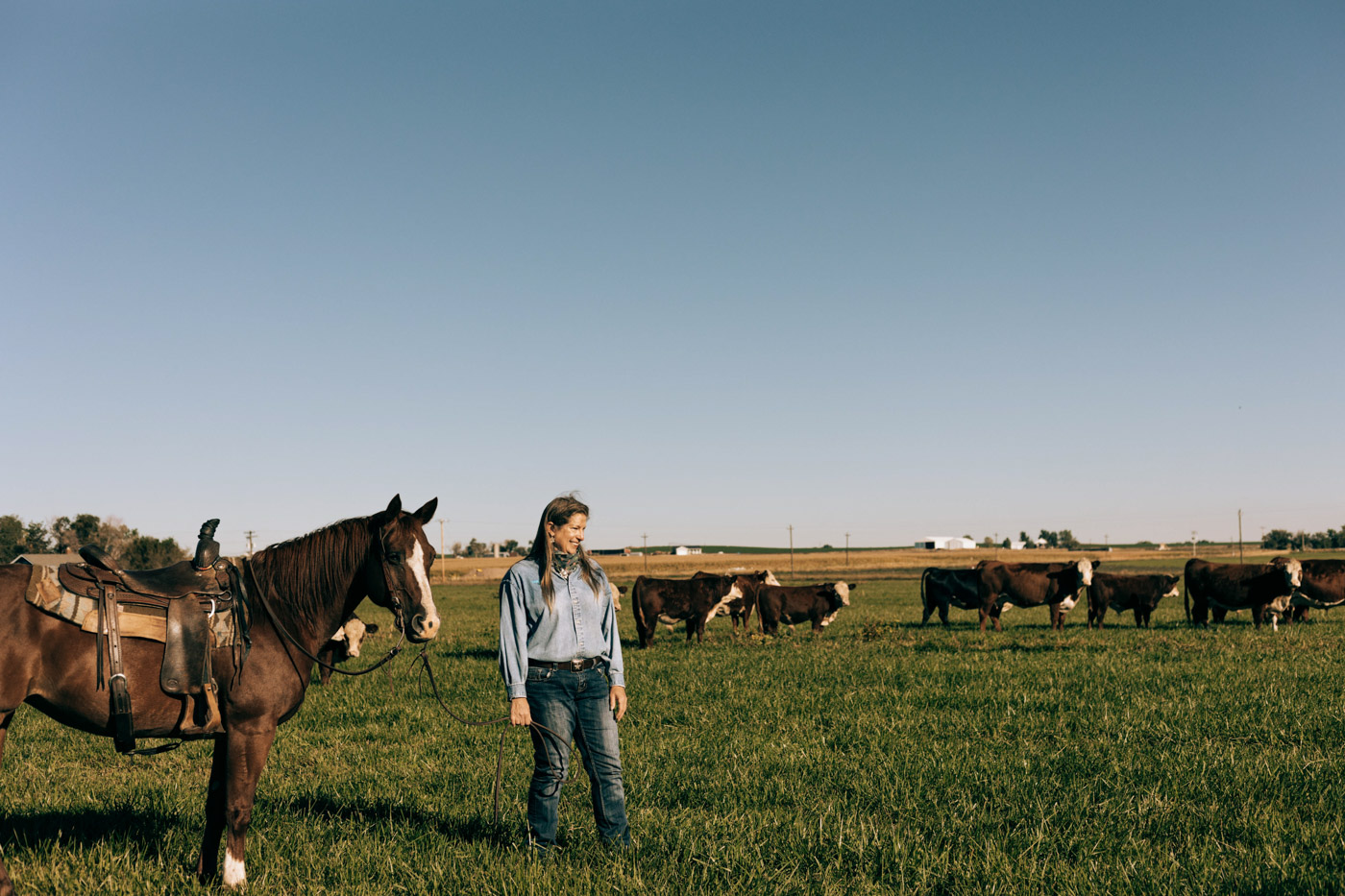
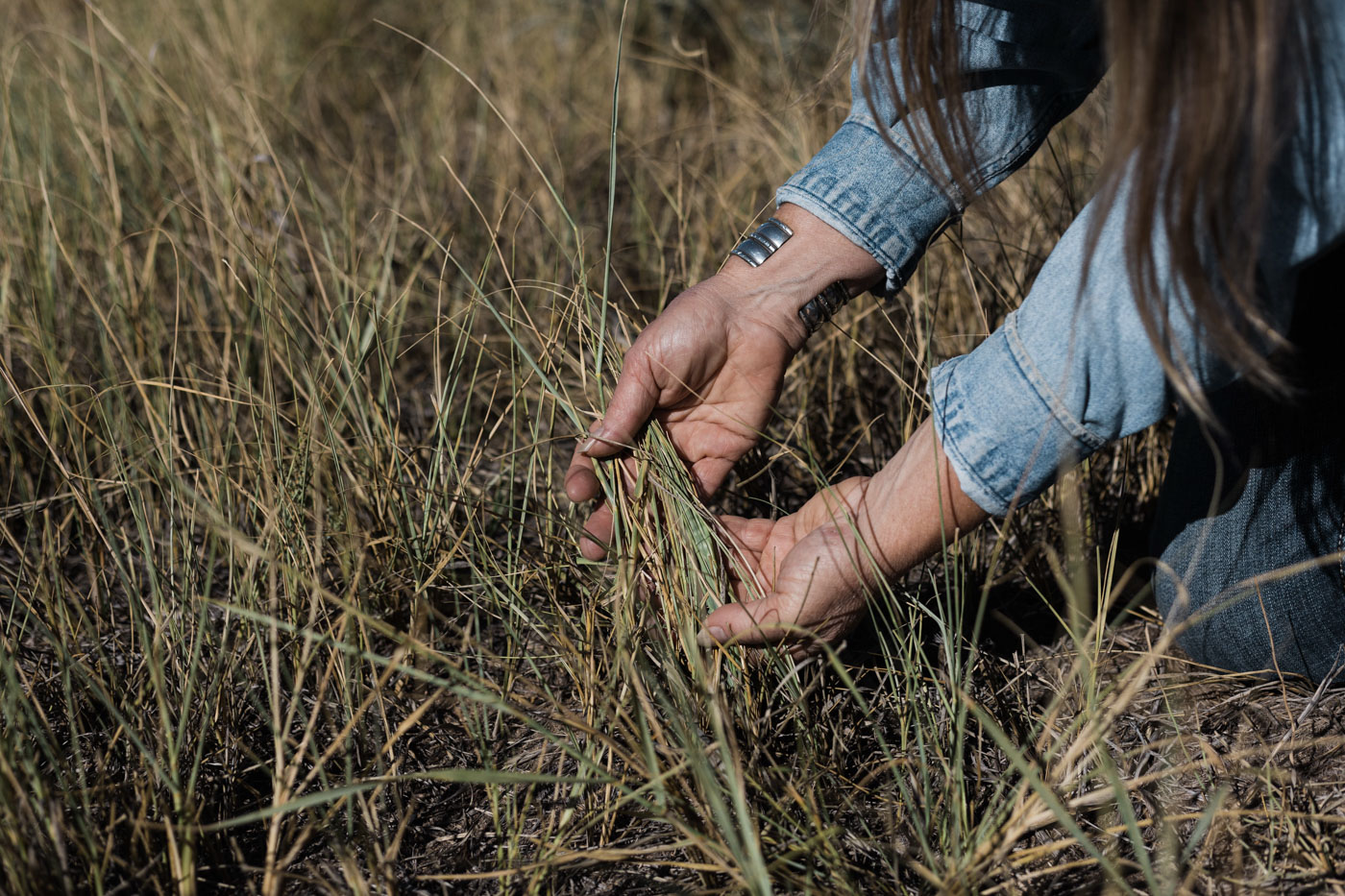
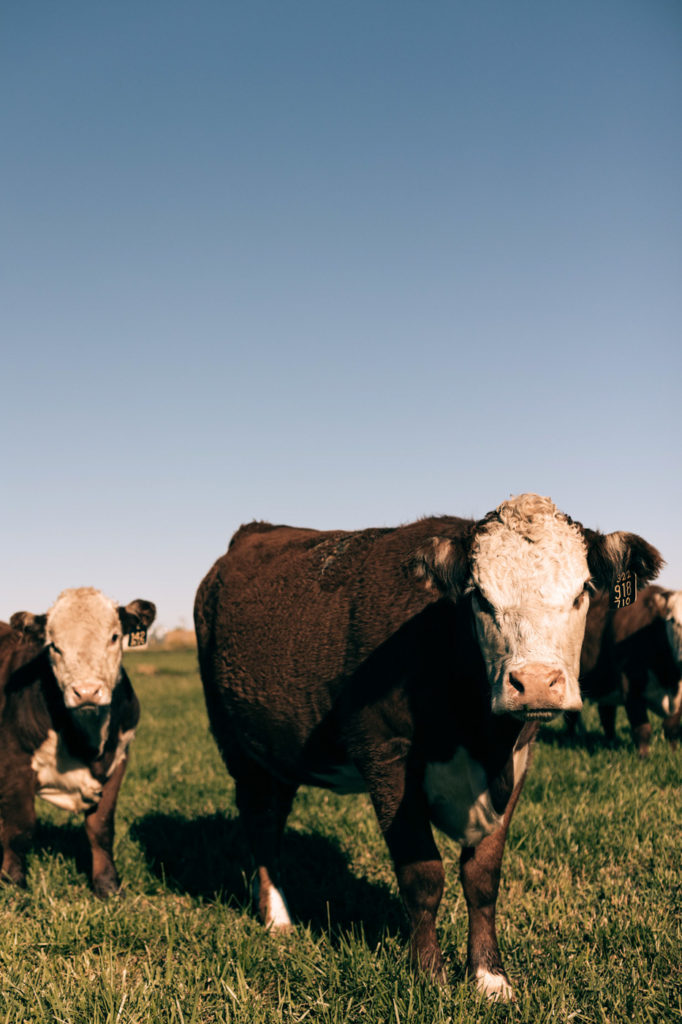

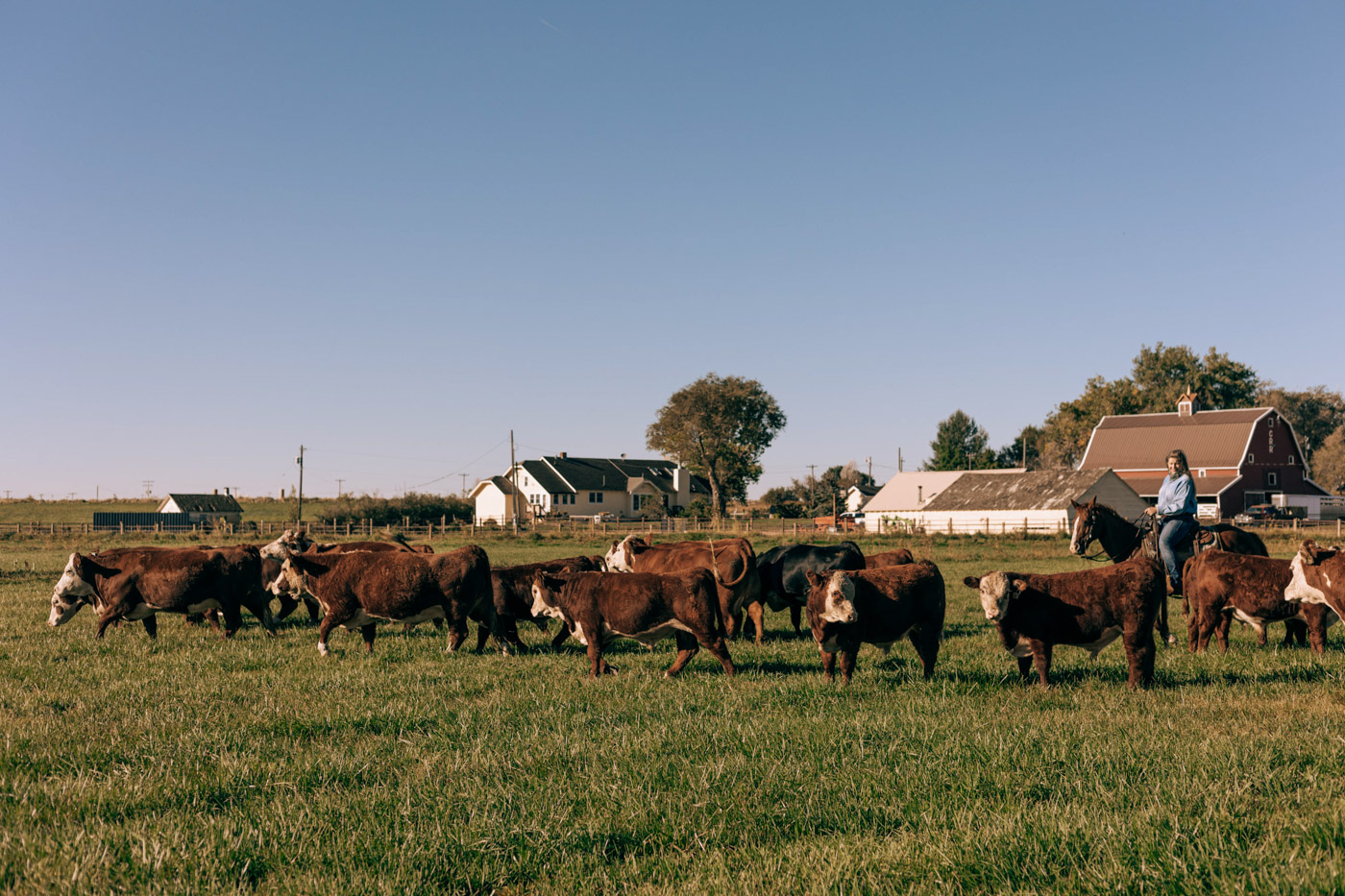
Cornelius’ own family runs a ranch in eastern Colorado with distant views of the Rocky Mountains. There, they graze about 160 mother cow and calf pairs across the rolling landscape, breeding Hereford cattle for their genetics, which are better adapted to the dramatic temperature swings of a high-altitude desert climate. Already 600 pounds at six months old—up from 80 at birth—the calves are able to gain an incredible amount of weight through milk and grass alone. The best of the bulls will eventually be offered for sale as studs, after maturing to an adult weight of 1,600 to 2,400 pounds.
“What people don’t realize is that mothers are the engine of any ranch,” Cornelius explains. “The best among them are able to efficiently convert grass into nutrient-dense milk.” Right outside the barn, the family’s cows enjoy a late-summer rotation on a lush green pasture of irrigated grassland—but those blades are predominantly made of water. To the south, sandier soils boast a range of wild grasses, offering a potent mix of nutrients due to the more challenging environment. “When the cows graze those sand hills, they not only improve their diet, but they actually help to reclaim otherwise barren land from invasive weeds or non-native plants,” Cornelius adds. “If you don’t overgraze, you’ll see the grasses root deeper and start to crowd out less desirable plants over time.”
According to Chris Kerston, a California-rancher-turned grasslands advocate, barren, ungrazed land is one of our greatest environmental enemies. As the chief commercial officer of Land To Market, a subset of The Savory Institute, his job is to connect farmers and ranchers who are achieving regenerative outcomes with mission-driven brands and consumers seeking greater environmental accountability. To achieve this goal, The Savory Institute has built a network of 51 regional hubs, which help to scale up implementation and measurement of ecosystem impacts across six continents. To date, the organization has influenced agricultural practices on more than 32 million acres around the world.
“For some reason, plant-based food gets this automatic free pass in our current zeitgeist,” Kerston notes. “Yet the number-one indicator of regenerative outcomes [in our research at The Savory Institute] is minimizing bare ground, which has an ineffective water cycle, risk of erosion, no potential for photosynthesis, and no biological diversity.” To improve soil health across the majority of this barren land requires more deep-rooted grasses, which can only prosper with well-managed grazing.
In his previous work as a rancher, Kerston experienced firsthand how animals contribute to thriving ecosystems. In particular, he spent several years running a 2,000-acre orchard in the Sierra Nevada, growing olives, citrus, stone fruit, pears and pomegranates. By introducing livestock into the orchard to cut the grasses and naturally fertilize the soil, his team was not only able to bolster the annual output of the orchard—they also reduced their overall fuel usage for machinery by 85%. “We often think of nature as ruthlessly competitive, but from the tundra, to the desert, to the jungle, you actually see flora and fauna working together in a collaborative way,” Kerston reflects. “If we want our food and fiber systems to mimic that natural abundance, we have to put plants and animals together.”
Interestingly, it’s not just domesticated livestock and crops that benefit from this cohabitation. On a recent trip to visit Wood’s ranch, Cornelius was accompanied by wildlife biologists from the National Audubon Society who work closely with Panorama’s team to set environmental standards. Rather than watching the birds in the sky or the grass-grazing cows, the biologists excitedly crouched over puddles in the pasture. “They kept saying, ‘I’ve never seen this many shrimp!’” Cornelius laughs. What the biologists spotted were thousands of vernal shrimp, a key food source for migrating birds who travel from Canada to South America each year. Those richly-populated puddles would never have existed if it weren’t for the cows’ hoof prints—which capture just enough rainwater to activate the dormant shrimp—dotting thousands of acres of pesticide-free grazed land.
Kerston helps ranchers measure similar signs of environmental impact through The Savory Institute’s Land To Market initiative. The five key metrics used by the organization to evaluate the regenerative potential of any agricultural practice are soil organic matter, water retention, biodiversity, overall ecosystem function and carbon sequestration. The latter is a new field of study, and perhaps the most underappreciated benefit of well-managed ranchlands. In addition to easily observable benefits like reduced erosion, recent science has shown that grazed land sequesters dramatically more carbon than barren or ungrazed pastures—arguably one of the most compelling arguments for including grass-fed livestock in our vision for a more sustainable agricultural future.
Of course, having the research and science to support regenerative ranching outcomes is just the first step. Ensuring these changes in land management are implemented on a widespread basis can be a bit tougher—and require structures that reward ranchers for investing in more sustainable practices. “At Panorama, we pay 25 to 30% over commodity beef prices to our ranchers,” Wood emphasizes. “That keeps them motivated to work within parameters that are better for the environment—and to keep supplying us with their product. Put simply, if you create the incentive, ranchers will do it.”
In addition to properly paying ranchers for their work, the industry is also desperate for an increase in small- to medium-sized meat processors, as more than 85% of all beef processed in the U.S. currently passes through just four high-volume processing plants. For brands like Panorama Organic, it’s not possible—or desirable—to work with these top four plants, leaving them to compete for limited space and, often, pay illogically high prices for processing. In 2019, the brand joined the Perdue Farms group, alongside such like-minded companies as Niman Ranch and Coleman Natural, to increase its access to infrastructure investment and overall negotiating power.
To support these investments, Kerston feels the industry may have to shift how it approaches processing and meat marketing in general. “There’s an opportunity for us to celebrate the differences in regions, breeds and the stories behind each animal. In wine, beer, chocolate and coffee, we already have an understanding of a product’s origin or terroir. If we can bring that knowledge down to the processing level and begin to specialize the profit model for meat, that’s where we’ll see the industry start to tip.”
Chefs—and consumers—can contribute to that industry shift by taking a greater interest in the full life cycle, provenance and ecological impact of meat sourcing. Rather than making decades-old assumptions regarding the quality of grass-fed beef, chefs may also be surprised to find that, when using appropriate breeds such as Hereford or Angus, ranchers can achieve marbling consistent with corn-fed or -finished animals.
“Part of the issue with grass-fed in the past is that there wasn’t consistency in the breed or the age of the animal at harvest,” Cornelius explains. “It’s more expensive to raise animals that way, and demand always outstrips supply, so some people are tempted to harvest lighter animals [than they should]. Chefs can help drive the demand for that consistency by working with brands like Panorama Organic.”
For Kerston, demanding—and producing—that quality also requires an ongoing evolution of research and education. “Holistic management moves away from our brain’s desire to break things down into a formula or a recipe. We can do scientific studies about best practices on a specific landscape, but you have to customize it to different ecoregions and the available inputs of the individual farmer.”
Which is to say regenerative ranching is far from the simple or easy path. Yet for individuals like Wood, who have turned a struggling family business into a multi-generational promise, the answer is clear: “Our ranchlands are a conduit for clean air, clean water, and there’s so much wildlife around us. It is virtually impossible to be successful in the grassland business without taking care of the environment, and it just so happens to benefit the bottom-line as well.”





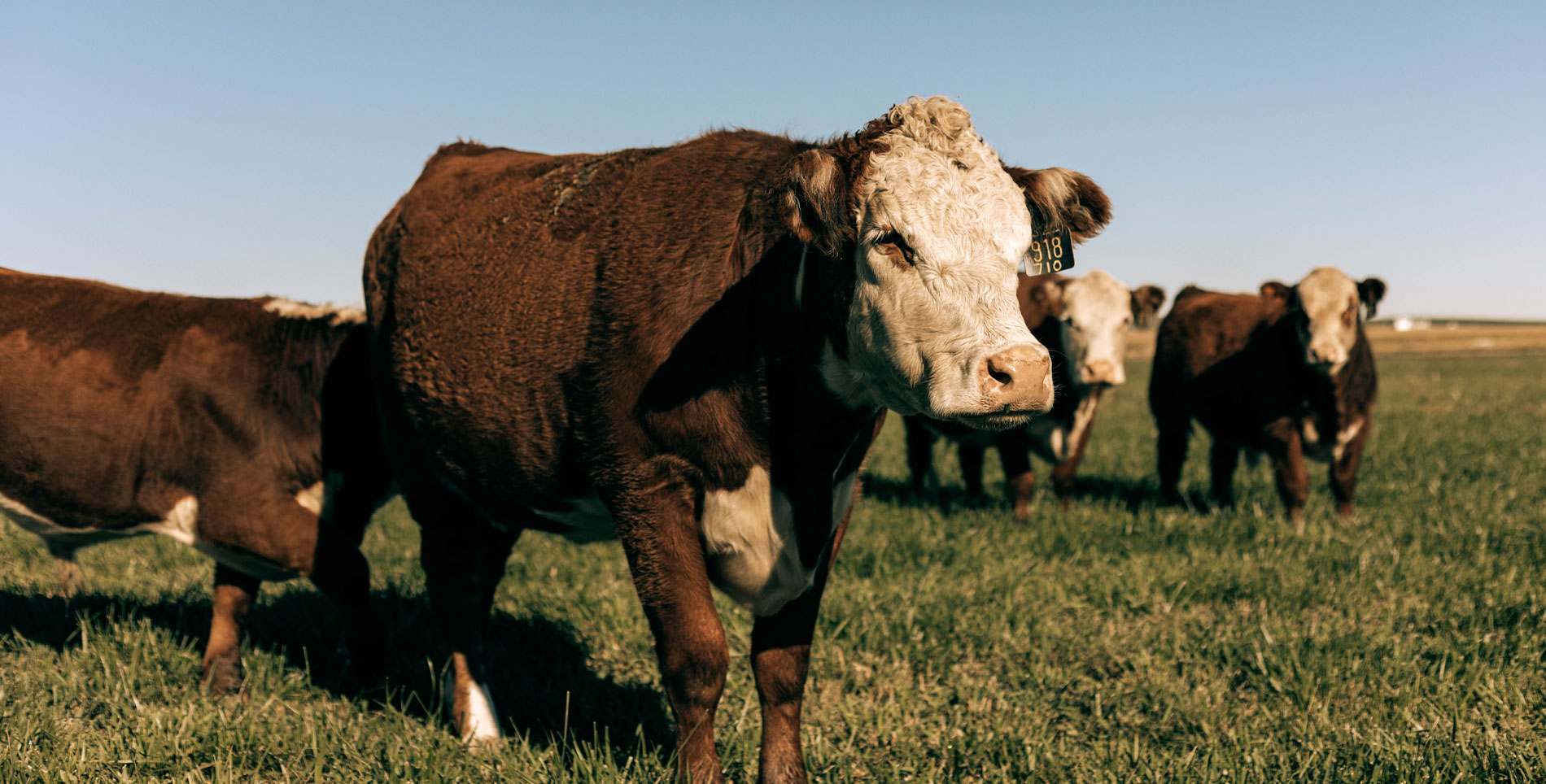

Our comments section is for members only.
Join today to gain exclusive access.